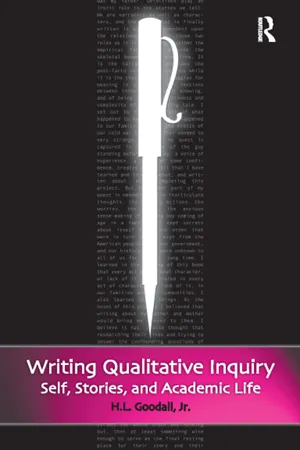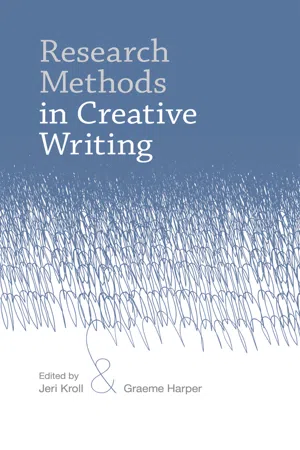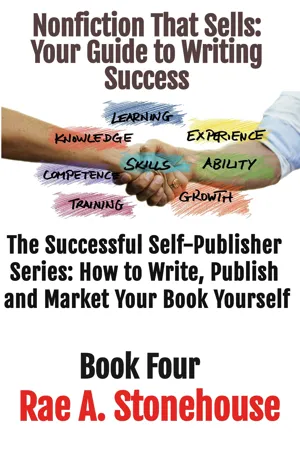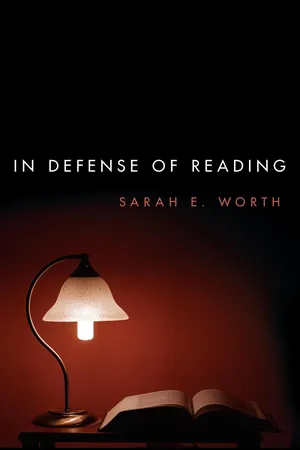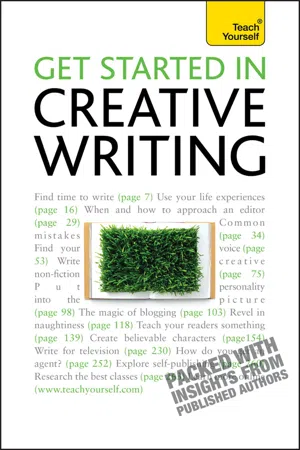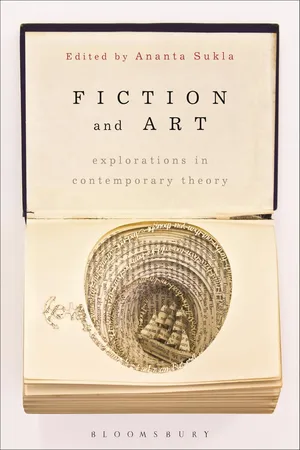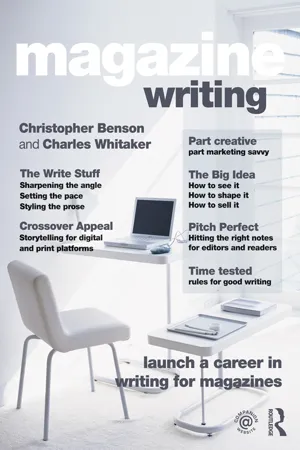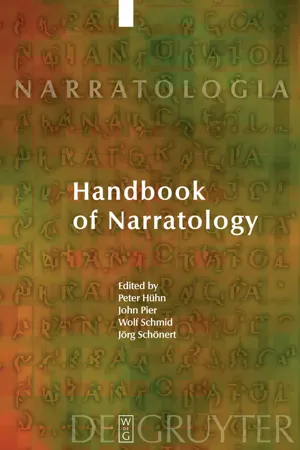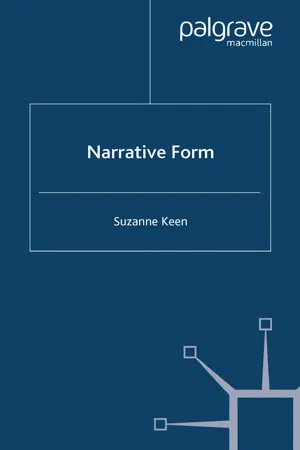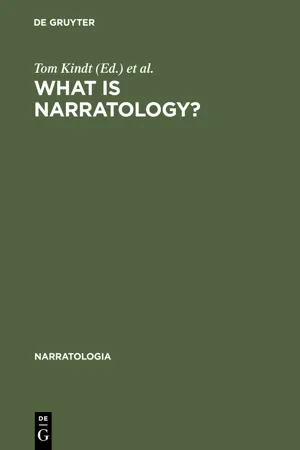Literature
Creative Non-Fiction
Creative non-fiction is a genre of writing that combines factual information with literary techniques to create engaging and compelling narratives. It encompasses a wide range of forms, including personal essays, memoirs, and literary journalism. This genre allows writers to explore real-life experiences and events in a creative and artistic manner, blurring the lines between fact and fiction.
Written by Perlego with AI-assistance
Related key terms
1 of 5
12 Key excerpts on "Creative Non-Fiction"
- eBook - ePub
- Tonya Krouse, Tamara F. O'Callaghan(Authors)
- 2020(Publication Date)
- Bloomsbury Academic(Publisher)
The newness of creative nonfiction to Creative Writing says less about the genre than it does about the ways in which the academic field historically valued the genres, seeing less worth in writing that it regarded as journalism in comparison with writing that it regarded as art. In the twenty-first century—especially with the explosion of communication and media technologies that accompany the widespread use of the internet—creative nonfiction becomes one of the fastest-growing, best-selling genres of Creative Writing. Creative nonfiction encompasses personal narrative forms such as autobiography, life writing, and memoir as well as narrative forms more public in nature, including occasional writing, long-form feature or investigative reporting, biography, and commentary. Each of these forms can appear across ranges of length, from short-form essay to book-length work. Creative nonfiction writers also sometimes practice mixed-genre writing, in which they merge elements of the above creative nonfiction forms into a piece that does not fit neatly into just one of the forms. Truman Capote, David Foster Wallace, Elizabeth Gilbert, Helen Macdonald, Ta-Nehisi Coates, and Karl Ove Knausgard are well known for their writing in the creative nonfiction genre. The focus of creative nonfiction on producing aesthetic ally pleasing narrative using the techniques more commonly associated with literary genres of poetry and fiction is what distinguishes it from journalism, a writing form that focuses less on aesthetics and more on providing the public with important information needed for daily living. While writers of creative nonfiction root their creations in true stories, their emphasis, like writers of fiction, is more on telling a good story than on timeliness or relevance, the criteria that typically guide journalists who report the news - eBook - ePub
Writing Qualitative Inquiry
Self, Stories, and Academic Life
- H.L. Goodall Jr(Author)
- 2016(Publication Date)
- Routledge(Publisher)
I was strongly attracted to academic literature—great ideas, interesting theories, inspired applications—and the ongoing conversations about them. I was also dismayed by the tough going that characterized much of the prose that was used to write theory and report on practice. Why couldn’t a research-based form of inquiry also be a compelling narrative?That was when I decided to supplement my academic training in rhetoric and communication studies with work in creative and biographical writing. My first exploration into that parallel world was in a nonfiction-writing graduate class, where I was introduced to the idea of “new journalism” under the heading “creative nonfiction.”Lee Gutkind, founder of the Foundation for Creative Nonfiction, defines creative nonfiction as:Dramatic, true stories using scenes, dialogue, close, detailed descriptions and other techniques usually employed by poets and fiction writers about important subjects—from politics, to economics, to sports, to the arts and sciences, to racial relations, and family relations. Creative nonfiction heightens the whole concept and idea of essay writing. It allows a writer to employ the diligence of a reporter, the shifting voices and viewpoints of a novelist, the refined wordplay of a poet and the analytical modes of the essayist.3He explains that creative nonfiction emerged in the 1960s and 1970s under the banner of “new journalism,” which was an experiment in genre that infused investigative reporting with structural and stylistic techniques borrowed from fiction, drama, and poetry. Gutkind calls creative nonfiction “the literature of reality,”4 and credits Gay Talese5 as one of the earliest and best practitioners. Talese described his writing as an attempt to get at “the larger truth,” which is, Gutkind observes:What the creative nonfiction writer is always seeking, both the literal journalistic fact-oriented truth and the three dimensional truth or the meaning of what it is they have observed and experienced. The meaning is what we are working for and the meaning is the way we are able to render the objectives, the reason we have become writers. We have become writers to help make a change in the world and by capturing the meaning of what it is we see and hear, what it is we observe, we can help change, a very little bit of how a reader perceives an idea, a human being or a situation.6 - eBook - ePub
- Jeri Kroll, Graeme Harper(Authors)
- 2012(Publication Date)
- Bloomsbury Academic(Publisher)
14 But, writers know, and have known for a long time, that the real world cannot be directly rendered into text. The novelist Henry James, for instance, wrote of the difficulty of trying to report the complexity of experience in his books, and this is an even more significant issue for non-fiction authors:Experience is never limited, and it is never complete; it is an immense sensibility, a kind of huge spiderweb of the finest silken threads suspended in the chamber of consciousness, and catching every airborne particle in its tissue.15Given the difficulties of representing the intricacies of life in literature with any accuracy, and assertions that the idea of any absolute truth is outmoded, contemporary authors have found that writing non-fiction with these complexities in mind is a challenging task. In attempting to deal with these complexities, they have conducted important research into such issues as defining ‘truth’. Their findings on this topic have discussed, for instance, the differences between factual and aesthetic truths, and the ways that authors can signal to their readers how they have dealt with such issues as gaps in their data sets, or conflicting evidence. This is especially important as while readers do have an expectation that non-fiction texts will relay ‘the truth’, they are also very accepting when authors explain the limitations in both their evidence and their own abilities. In the birthday party memory, for instance, the writer will have some data that represents fairly certain truths – who was present, how old they were at the time, what they were wearing, what food was served, what the weather was like, where the party was held, and so on. There will also be a myriad of issues that are less clear: who said what, for instance, and to whom. Even once this is ascertained, there is the more difficult question of what was meant by what was said, which will, of course, always be a matter of interpretation. The seemingly innocuous ‘Happy Birthday’, for instance, can be stated with warmth or delivered in a snide and/or ironic fashion, or with a myriad of other intentions falling between these. Even the most banal facts might not be agreed on by all the guests at the party. A photograph could show everyone around the table, but cut off at the waist. What shoes everyone was wearing could be a point of debate, as could be who was the last to leave and other such matters. - eBook - ePub
Literature for Young Adults
Books (and More) for Contemporary Readers
- Joan L. Knickerbocker, James A. Rycik(Authors)
- 2019(Publication Date)
- Routledge(Publisher)
In contrast, works of literary nonfiction can be thought of as those that easily lend themselves to an aesthetic stance. Literary nonfiction is sometimes called creative nonfiction, narrative nonfiction, or literature of reality. It has also been labeled the “fourth genre” to elevate it to the status of literature, while distinguishing it from poetry, fiction, and drama (Root & Steinberg, 2010). Literary nonfiction:recognizes both the inherent power of the real and the deep resonance of the literary. It is a form that allows a writer both to narrate facts and to search for truth, blending the empirical eye of the reporter with the moral vision the—I—of the novelist.(University of Oregon, n.d., p. 1)Nonfiction has come to play a much greater role in middle and high school language arts classrooms. Content Learning Standards for English Language Arts (2018) in the state where we live, Ohio (education.ohio.gov), were influenced by the Common Core State Standards for the English Language Arts (National Governors Association, 2010). Beginning with the sixth-grade standards, the term “literary nonfiction” replaces “informational texts” in the category of “reading information.” The result is to reposition nonfiction in the curriculum, giving a much greater emphasis to creative nonfiction than it had in the past.Both literary and informational works of nonfiction may be read outside of school as part of a young adult’s personal reading, but, in the classroom, teachers can acquaint their students with the many genres of nonfiction and guide them to recognize the elements that characterize each genre.The Genres of Nonfiction
There is not a universal system for categorizing the genre of a nonfiction work. The following genres were chosen to aid in selection and instruction for works of nonfiction that were either written for young adults or may have a particular appeal to that audience.Biography
A biography is the history of a person’s life written by someone else; it can also focus on several persons, which is called a collective biography. Biographies can be about a person’s entire life, or they can be a partial biography and focus on only a portion of that person’s life. The books that are presented as follows are excellent examples of life stories that are supported by extensive research. They provide the stories not only of the lives of individuals but also of the times and places in which they live. - eBook - ePub
Nonfiction That Sells
Your Guide to Writing Success
- Rae A. Stonehouse(Author)
- 2023(Publication Date)
- Live For Excellence Productions (LFEP)(Publisher)
CHAPTER ONEINTRODUCTION TO WRITING NONFICTION: UNDERSTANDING THE GENRE, ITS MARKET, & YOUR TARGET AUDIENCE
Understanding Nonfiction Writing: Looking at What Makes Nonfiction Different from Things Like Fiction and PoetryNonfiction writing refers to a genre that presents factual and real-life information. It encompasses works based on truth, evidence, and research, providing a window into reality rather than representing imaginary stories as found in fiction or evoking emotions through metaphors like poetry. Nonfiction writing encompasses various forms, including essays, biographies, memoirs, news articles, scientific reports, and academic papers, among others.The fundamental feature of nonfiction writing is its basis in reality. It aims to inform and educate readers about real-world events, people, places, ideas, or concepts. Nonfiction writers conduct extensive research, relying on primary and secondary sources that offer reliable and verifiable information. This research-driven approach ensures accuracy, supports arguments with evidence, and lets readers gain a deeper understanding of a topic.On the other hand, fiction writing is characterized by its imaginative and creative elements. Authors create fictional worlds, characters, and events that might be inspired by real-life experiences. In fiction, the primary intention is often to entertain, evoke emotions, or explore complex themes through storytelling.While nonfiction revolves around facts, fiction uses elements of storytelling such as plot development, character arcs, and narrative techniques to engage readers. Fiction writers have the freedom to invent scenarios and characters, enabling them to explore unique perspectives or present thought-provoking ideas without being confined to real-world limitations.Similarly, poetry distinguishes itself from nonfiction by emphasizing the aesthetics of language, along with evoking emotions and conveying deep meaning through metaphor, symbolism, and imagery. Poets use various techniques, such as rhyme, rhythm, and meter, to create musical and lyrical compositions. The purpose of poetry often extends beyond conveying information, focusing more on personal expression, highlighting emotions, or encapsulating complex ideas in a condensed form. - eBook - ePub
- Sarah E. Worth(Author)
- 2017(Publication Date)
- Rowman & Littlefield Publishers(Publisher)
Fiction is not a conglomeration of false sentences. It cannot be seen only as a negation of truth. It is an intentional construction of a certain kind. Things described in fictions can and often do correspond to real places, persons, and events, but fictions are not necessarily about real places, persons, and events. Fiction is a literary genre that is to be read in a particular way. Stories or narratives are a form of explanation and, as explanations, are used as justification in ways corresponding to those in which we validate truth claims. Conversely, nonfiction is also a literary genre that we are taught to read in a particular way and is dependent upon certain social and literary conventions for us to understand properly. It is not merely that which is true, simpliciter. One of the preconditions of nonfiction is that it is both true and something that can be documented. What is true also goes well beyond just “what happened” or what corresponds to “reality.” Nonfictional literature does not just appeal to a simplistic version of truth as “what really happened.” Narratives written about true events, events that really happened, are still largely constructed into stories by editing time, event, setting, tone, character, and emotion, and often by constructing or inventing causation. Narratives are also always written from a particular perspective. Nonfiction does not and cannot embrace only true accounts of an omniscient narrator. Nonfictional literature is a genre of storytelling that includes true events, but it can include much more also, like emotionally laden perspectives that could never be derived from “facts alone” or “true events.” Moreover, nonfiction includes a descriptive aspect that is necessarily inserted by a narrator - eBook - ePub
- Stephen May(Author)
- 2010(Publication Date)
- Teach Yourself(Publisher)
6
Creative Non-Fiction
In this chapter you will learn:- what Creative Non-Fiction is
- how to find a subject
- how to think about structure
- how to write a proposal.
What is Creative Non-Fiction?
Creative Non-Fiction is becoming the most widely used term to cover memoir, biography, autobiography, travel writing and writing about historical events. All these kinds of writing have always been popular, but in recent years there has been an increase in demand for works in these genres. More than ever, audiences seem to crave ‘authenticity’ and ‘real life’. The truth is that in order to work, non-fiction requires the same creative writing skills as those of fiction. It needs a solid structure, a compelling narrative voice and a clear connection of ideas. The ‘truth’ of your work will not necessarily be what engages your readers, it will be how well you present that truth.WHY BECOME A NON-FICTION WRITER?
Everyone tells real-life stories. Everyone comes home from even the simplest journey with an anecdote to tell. Something that happened to them or something they saw; a funny story told to them in a shop, or at work. We are a storytelling species. It is how we make sense of the world around us. For most people these stories are true. Real things that happened to real people in real places. Nevertheless everyone – often without realizing it – crafts their story. Shapes it so that it becomes more entertaining for the listener. In this way everyone already has the basics for producing great non-fiction work instinctively. Some people will be better at it than others, just as some people are naturally faster than others, but we all have the basic tools and can develop this native ability.Everyone has had important, dramatic, surprising things happen to them. Equally, every family history is filled with characters and dramas: little legends that demand telling. And the broad sweep of history too, features people who have been forgotten and neglected. People whose stories deserve retelling for new audiences. As the writer of these stories, whether your own or other people’s, you will gradually become an expert in some area of life. Your area of expertise might be narrow, but nevertheless part of the appeal of becoming a writer of non-fiction is that you will be the authority on the stories you choose to tell. - eBook - PDF
Fiction and Art
Explorations in Contemporary Theory
- Ananta Ch. Sukla(Author)
- 2015(Publication Date)
- Bloomsbury Academic(Publisher)
The standards are different. We desire transparency where we may never find it. The genre of nonfiction promises something it can never deliver in full, but only verisimilitude. Whereas we expect fiction to be constructed intentionally, and the story elements are applied in ways in which we make sense of the form we are accustomed to, nonfiction struggles with this a bit more. If we take Nussbaum’s explanation of the relationship between form and content to be one that holds, I might have to return to the claim that literary nonfiction is not a category distinction we can defend at all. It might be said to be an oxymoron, reducible to ‘assembled truth’. Nonfictional content cannot have a literary form since the ways in which we develop story is inimical to the ways in which we describe truth or reality. But whether or not I am philosophically opposed to the category designation, it remains a meaningful designation for cataloguing and it is one that is appealing to readers. So what do I tell my son about his book? Is the story of Stone Soup real or not? I don’t think it happened, but that is not to say that it couldn’t have happened. Hopefully, in many places, events like that happen where communities come together and individuals contribute to make big communal pots of soup. But that is not satisfactory. We may never have a satisfactory answer to the question ‘is the story true?’ since truth cannot be a modifier to story in the ways in which we want it to be. Stories are constructions, and even the ones that are connected to reality in part cannot be said to be true in the way in which philosophers take (seriously) the notion of truth. Notes 1. See, for instance, Friend (2011). Here she argues that fiction and nonfiction are most accurately designated primarily as genre distinctions, which often have overlapping characteristics and are not easily differentiated by any necessary and suffi cient conditions attributable to fiction and nonfiction. - eBook - ePub
- Christopher D. Benson, Charles F. Whitaker(Authors)
- 2014(Publication Date)
- Routledge(Publisher)
For example, good characters have dimension. They are not all good, nor are they all bad. The writer of literary non-fiction will want to show the full range of qualities in writing about people. This involves probing interviews that sometimes go off topic just to explore certain character traits or background information. ▶ Literary Non-Fiction Process As you can see, good non-fiction employs many of the techniques of short fiction, except, of course, the fiction part. We must keep in mind that the stories we write for magazine publishing are expected to be real; they are expected to be factual. That is why so much emphasis is placed on the reporting—or fact-gathering—component of this form. There is great pressure on the writer to become immersed in the story, spending many hours researching even the smallest details and focusing on probing interviews that sometimes can require days of full access to sources. The result, though, is rich storytelling that engages and entertains the reader, even while informing. Narrative detail These stories must provide description. This description, in turn, is highly detailed. But here, the quality of specific details will outweigh the quantity. The accomplished writer in this form will provide the detail that is necessary to tell, or show, the story. What does a particular hand gesture say about the character you are revealing? And what does that character say about the issue she is illustrating? This is what must be kept in mind as you absorb all the details in your work. And, obviously, that work involves research, interviews, and the writer’s observations. In this way, you will be able to provide description of place and situations as well as people and character. With respect to people, there are a number of details to capture, including speech, appearance, and manner. What does the voice sound like? Capture real-life dialogue as Professor Harrington suggests - eBook - PDF
- Peter Hühn, John Pier, Wolf Schmid, Jörg Schönert, Peter Hühn, John Pier, Wolf Schmid, Jörg Schönert(Authors)
- 2009(Publication Date)
- De Gruyter(Publisher)
Indeed, fiction, and its species narrative fiction, are best understood as a specific way of producing and using mental representations and semiotic devices, be they verbal or not. This means that narrative and fiction are intersecting categories and must be studied as such (see Martínez & Scheffel 2003). 2.3 Types of Fiction The difficulty of getting a clear picture of the distinction between fac-tual and fictional narrative results in part from a long history of shifting uses of the term “fiction.” The sense which is most current today—that of a representation portraying an imaginary/invented universe or world —is not its original nor its historically most prominent domain of refer-ence. In Latin, fictio had at least two different meanings: on the one hand, it referred to the act of modeling something, of giving it a form (as in the art of the sculptor); on the other hand, it designated acts of pretending, supposing, or hypothesizing. Interestingly, the second sense of the Latin term fictio did not put emphasis on the playful dimension of the act of pretending. On the contrary, during most of its long his-tory, “fiction,” stemming from the second sense of the Latin meaning, was used in reference to serious ways of pretending, postulating, or hy-100 Fictional vs. Factual Narration pothesizing. Hence the term has usually been linked to questions of ex-istence and non-existence, true and false belief, error and lie. In classical philosophy, “fiction” was often used to designate what we today would call a cognitive illusion (→ illusion). Hume used the term in this sense when he spoke about causality or about a unified self, calling them “fictions” (Hume [1739] 1992: Bk I, Pt IV, Sec VI). Now, this type of fiction, as Hume himself explicitly stated, is quite different from fiction in the artistic field. It is part of the definition of a cognitive fiction that it is not experienced as a fiction. A narrative fic-tion, by contrast, is experienced as a fiction. - eBook - PDF
- S. Keen(Author)
- 2003(Publication Date)
- Palgrave Macmillan(Publisher)
The notion that a press’s labeling a work ‘historical fiction’ constitutes ‘defamation of char- acter’ heightens the importance of generic labels. The author believes he has created a work of nonfiction from documentary sources and names it ‘creative nonfiction.’ The press markets the work in a nonfiction line, 136 Narrative Form implying its value to historians as a documentary source. Journalists reveal the truth of the text’s fabrications through investigative reporting in the news. The negative publicity and the imputation of fraud may have been factors in the University of Arizona Press’s decision to let Boyer’s text go out of print (in 2000). 10 Some 300 years after the period studied by Davis, the process of separation of fiction from history is still being worked out through real and threatened lawsuits. Barbara Foley extends Davis’s observations about the movable boundary between fiction and fact, a boundary that was articulated during the seven- teenth century through the application of libel law. In her work on the documentary novel, Foley argues that factual and fictional forms of writing are not ‘immutable essences’ but should be understood instead as ‘histori- cally varying types of writing, signaled by and embodied in, changing liter- ary conventions and generated by the changing structures of the historically specific relations of productions and intercourse’ (Telling the Truth, 27). Foley explores those shifting boundaries, and the material con- ditions of authorship and historical contexts that help to move them, in her study of the documentary novel, a hybrid form of narrative. Foley describes the documentary effect generated by these narratives, which purport ‘to represent reality by means of agreed-upon conventions of fictionality, while grafting onto [their] fictive pact some kind of additional claim to empirical validation’ (25). - eBook - PDF
What Is Narratology?
Questions and Answers Regarding the Status of a Theory
- Tom Kindt, Hans-Harald Müller, Tom Kindt, Hans-Harald Müller(Authors)
- 2008(Publication Date)
- De Gruyter(Publisher)
The violent reactions, created from a sense of betrayal, which inevitably arise once a faked autobiogra-phy is disclosed as such verify quite clearly that the reading public does distinguish not only between fact and fiction (i.e. factual and fictional dis-course) but also between fake and fiction. (b) Let us consider now some intratextual aspects of narratives. With regard to a narrative's discourse (discours) some factual genres are sometimes said to subvert the borderline towards fictional texts. Take the case of the New Journalism. In the 1950ies, authors like Tom Wolfe or Gabriel García Márquez began to utilize in their journalistic writings nar-rative techniques which by then had been conceived of as signposts of fic-tionality—verbatim representation of dialogues which took place in the journalist's absence and without having been mechanically documented, and, most importantly, devices of internal focalisation like interior mono-logue, stream of consciousness, and free indirect discourse 32 . In New 31 See Mächler (2000). 32 See Wolfe (1973). 230 Matías Martínez, Michael Scheffel Journalism, however, such devices appear in reportages which are meant to provide a factual representation of events which really took place. One of the most prominent examples of this new kind of journalistic writing was Truman Capote's In Cold Blood (1965) which told the story of the murder of a Kansas farm familiy by two young men who subsequently were condemned to death and eventually executed. Its subtitle, A True Account of a Multiple Murder and Its Consequences, indicates the undi-minished claim for truth which is essential to the proper understanding of such pieces of narrative. In spite of the utilization of devices of internal focalization etc., Capote aspired to tell the truth about the consciousness of the murderers.
Index pages curate the most relevant extracts from our library of academic textbooks. They’ve been created using an in-house natural language model (NLM), each adding context and meaning to key research topics.

